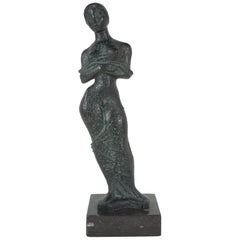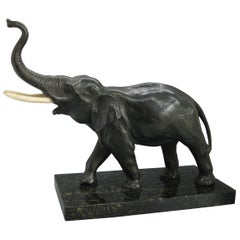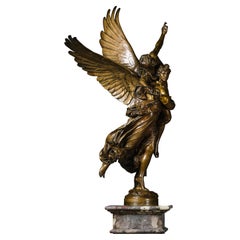Georges Oudot
to
1
1
1
Dealer: Gottlieb Gallery
Cast Bronze Figure by Georges Oudot “Femme Debout Au Drape"
By Georges Oudot
Located in Hudson, NY
this work by famed Sculpture and Painter Georges Oudot was cast circa 1955 and bears his signature and the mark EA indicating its an artist proof, the foundry stamp of Susse Fondeur Paris. Entitled “Femme Debout au Drape” the work is dynamic and powerful as are almost all of the artist's figural works in bronze. The figure is cast and retains its original patina in a dark black-green. The artist's hand and the textural nature of his work are clearly evident in this piece. He was born in France in 1928 in Chaumont in the Haute-Mare. He attended the Besancon School of Fine Arts then in 1946 joined the Ecole des Beaux-Arts in Paris and studied under such artists as Marcel Gimond...
Category
Mid-20th Century French Modern Georges Oudot
Materials
Bronze
Related Items
Antique Cast Bronze Elephant Figural Statue Sculpture on Marble Base
Located in San Diego, CA
Great cast bronze elephant sculpture mounted on a marble base. Elephant has wonderful details and appears the tusks were replaced over time. Base has one tiny edge chip. Elephant has...
Category
Early 20th Century Georges Oudot
Materials
Bronze
‘Gloria Victis’, A Patinated Bronze Figural Group by Mercié, Cast by Barbedienne
By Ferdinand Barbedienne
Located in Brighton, West Sussex
A Patinated Bronze Figural Group of ‘Gloria Victis’ (‘Glory to the Vanquished’), Cast by Ferdinand Barbedienne from the Model by Marius-Jean-Antonin Mercié (French, 1845-1916).
‘Gloria Victis’ (‘Glory to the Vanquished’).
Bronze, gilt and dark brown patina.
Signed 'A. Mercié', with foundry inscription 'F. BARBEDIENNE, Fondeur. Paris.' and A. Collas reduction cachet. The integral base titled 'GLORIA VICTIS'.
This cast is part of a limited edition by the Barbedienne Foundry.
France. Circa 1880.
‘Gloria Victis’ is one of the most recognisable and important works of sculpture of the nineteenth century and a definitive image of France’s historic national identity. The figure of glory, winged and wearing armour, carries a dying young warrior heavenwards towards fame and immortality. The compositional daring of the group must be admired for balancing two figures on the minimal support of one foot, wings spread in the moment before taking flight.
Mercié was a student at the French Academy of Rome when the Prussians invaded France in 1870. Shortly after the war had begun, he executed a group depicting the figure of Fame supporting a victorious soldier. When news reached Mercié in Rome that the French had surrendered, he decided to alter his group, replacing the victorious soldier with a defeated casualty, thus transforming an allegory of ‘Glory to the Victors’ into one of ‘Glory to the Vanquished’. Completed in 1872, a year after the defeat of French soldiers against the Prussian army, the statue personifies a defeated but heroic France. The title is also a reversal of the famous formula, ‘Vae Victis’ (Death to the Vanquished), which the Gallic general Brennus exclaimed upon defeating the Romans in 390 BC. The figure of the fallen soldier was thought to represent Henri Regnault, a fellow sculptor of Mercié who was killed on the last day of fighting.
Measuring 317 cm. high the original group of ‘Gloria Victis’ was unveiled in plaster at the Salon of 1872. It was bought by the City of Paris for the sum of twelve thousand francs and then cast in bronze by Victor Thiébaut for eight thousand five hundred francs. The bronze was exhibited at the Salon in 1875 and first placed in Montholon Square in the 8th arrondissement. In 1884 it was transferred to the courtyard of the Hôtel de Ville and in 1930, it entered the collection of the Musée du Petit Palais, where it can be seen to this day.
The Thiébaut Frères foundry also cast Gloria Victis bronzes for the cities of Niort (requested 1881) Bordeaux (requested 1883), Châlons-sur-Marne (today, Châlons-en-Champagne; requested 1890), and Cholet (requested 1901). In 1905, the Danish brewer and art collector Carl Jacobsen was permitted to have an exact cast made of the original sculpture in Paris, on condition that the base was made 2 cm lower and bore the inscription “Original tilhører Paris By” (The original belongs to the City of Paris). It too was cast by the Thiébaut Frères foundry. Gloria Victis was one of Jacobsen’s most important and his last acquisition. Today it has been returned to its original position in the Winter Garden at Glyptoteket, Copenhagen, Denmark.
The full-size plaster was shown again at the Paris Expositon universelle of 1878 alongside a bronze reduction by Barbedienne. By this time Antonin Mercié had entered into a commercial edition contract with the Ferdinand Babedienne foundry to produce bronze reductions of Gloria Victis, his most famous work. Gloria Victis is first recorded to have been produced in three sizes and by 1886 Barbedienne’s ‘Catalogue des Bronzes D’Art’ lists six sizes measuring 3/5, 9/20, 7/20, 3/10, 6/25 and 2/10, of the original. These reductions were produced by an invention of Barbedienne’s business partner Achille Collas. The Collas reducing machine was a type of complex mechanical pantograph lathe that enabled sculpture to be mathematically measured and transcribed to scale, in the round, thus making a reduced size plaster from which a bronze could be cast.
Mercié's modern sculpture had become an instant classic, even receiving an entry in the Nouveau Larousse Illustré. The success of the group undoubtedly lay in the fact that it was admired not just on an aesthetic level, but also on a patriotic level, particularly in its commemoration of heroism in defeat. Immediately ‘Gloria Victis’ was recognised as a national artwork, capable of arousing patriotism and casts were ordered from Barbedienne as local memorials commemorating the war’s dead for cities across France. ‘Gloria Victis’ was considered so much a part of France’s national identity that for the 1900 Paris Exhibition, Ferdinand Barbedienne’s nephew Gustave Leblanc, loaned a bronze example to feature as part of l’Exposition centennale de l’art français.
Literature:
For an interesting account of the process of creating a reduction in bronze of the Gloria Victis by Barbedienne and illustrations of the casting and finishing of the bronze see:
'Ferdinand Barbedienne': Theodore Child; Harper's new monthly magazine, Volume 73, Issue 436, September 1886.
‘Contemporary French Sculptors’: The Century, Volume 33, Issue 3, Jan 1887.
‘Modern French Sculpture’: Harper's new monthly magazine, Volume 76, Issue 452,
January 1888.
S, Lami, ‘Dictionnaire des sculpteurs de l'Ecole française au dix-neuvième siècle’, Tome III. G.-M., Paris, 1914, p. 432.
Peter Fusco and H.W. Janson, The Romantics to Rodin: French Nineteenth Century Sculpture from North...
Category
19th Century French Antique Georges Oudot
Materials
Bronze
H 41.74 in W 16.54 in D 14.18 in
“Femme Au Levrier” Art Deco Statue Bust by Raymond Leon Rivoire Sevres France
By Raymond Rivoire
Located in Oakland, CA
“Femme au Levrier” Art Deco statue bust by Raymond Leon Rivoire Sevres France circa 1937. Rare and important bust from the iconic Art Deco sculpture Raymond Rivoire...
Category
1930s French Art Deco Vintage Georges Oudot
Materials
Porcelain
H 9.5 in W 5.5 in D 7.5 in
Antique Figural Italian Cast Bronze Cat (circa 1920s)
Located in London, GB
Antique figural Italian cast bronze cat (circa 1920s). This Italian marvel, born in the heart of the 1920s, is not just a statue; it's a portal to a bygone era where craftsmanship an...
Category
1920s Italian Vintage Georges Oudot
Materials
Bronze
19th Century Animalier French Bronze Entitled "Taureau Debout" by Rosa Bonheur
By Rosa Bonheur
Located in London, GB
"Taureau Debout" by Rosa Bonheur.
An excellent late 19th Century French animalier bronze study of a standing bull with fine hand chased surface that accentuates the muscle definition of the subject, signed Rosa B.
ADDITIONAL INFORMATION
Measures: Width: 32 cm
Height: 18 cm
Depth: 11cm
Condition: Excellent Original Condition
Circa: 1870
Materials: Bronze
Book reference: Animals in Bronze by Christopher Payne
Page no. 174
DESCRIPTION
Bonheur, Rosa (1822-1899)
The most popular artist of nineteenth-century France, Rosa Bonheur was also one of the first renowned painters of animals and the first woman awarded the Grand Cross by the French Legion of Honor. A professional artist with a successful career, Bonheur lived in two consecutive committed relationships with women.
Born on March 16, 1822 in Bordeaux, Marie Rosalie Bonheur was the oldest of the four children of Raimond Oscar Bonheur (1796-1849) and Sophie Marquis. Bonheur's father was an art teacher who came from a poor family, while her mother, a musician, had descended from a middle-class family and had been her husband's art student.
Bonheur's father, who taught drawing and landscape painting, was an ardent member of the utopian Saint Simeon society.
The group held idealistic beliefs about the reform of work, property, marriage, and the role of women in society. Most importantly, for the artist's future, the Saint Simeons questioned traditional gender norms and firmly believed in the equality of women. While teaching artistic techniques to his oldest daughter, Raimond Bonheur also encouraged her independence and taught her to consider art as a career.
In 1828 Raimond Bonheur joined the Saint Simeons at their retreat outside Paris. Sophie and the children joined him in Paris the following year. Four years later, however, Raimond abandoned his family to live in isolation with his fellow Saint Simeons.
Sophie Bonheur died in 1833 at the age of thirty-six. Rosa was only eleven years old when her mother died, but she was aware of the heavy price her mother paid for married life with a man who was more dedicated to his own ideals than to meeting his family's needs. Rosa also saw that her mother's marriage led to poverty and her death from exhaustion.
After her mother's death, Bonheur was taken in by the Micas family who resided nearby. Mme Micas and Bonheur's mother had been friends. When Mme Bonheur died, the Micas family paid Raimond Bonheur's debts and cared for Rosa. Their daughther, Nathalie, who would later become an amateur inventor and unschooled veterinarian, and Rosa became enamored with each other.
When Rosa Bonheur began her career as a professional artist, she had already been trained by her father who had allowed her to study in all male classes. Rosa also learned by sketching masterworks at the Louvre from the age of fourteen, and later, by studying with Léon Cogniet.
From the very beginning, Bonheur's favorite subject was animals. She learned their anatomy completely by dissecting them in local slaughterhouses. She also visited the horse market two times a week. Study of animals by direct observation led to the formation of the realist style in which Bonheur worked.
It was for such work that Bonheur obtained written permission from the French government to wear men's slacks. Her working attire also consisted of a loose smock and heavy boots that protected her feet from the dangerous environment in which she painted. The style of dress that the artist adopted for work and home may well have been influenced by her father's attire, which was based on St. Simeonian clothing experiments. Bonheur also cropped her hair, perhaps to facilitate her work. She did, however, always wear dresses for social occasions because she knew that appropriate dress would further her career.
Bonheur earned a successful living as a painter of animals. She exhibited at the annual Paris Salon regularly from the age of nineteen in 1841 through 1853, when she was thirty-one. She won the salon's gold medal at the age of twenty-six in 1848 and was commissioned by the French government to paint Plowing on the Nivernais in 1849. In the same year Bonheur and her sister Juliette became directors of l'École gratuite de dessin pour les jeunes filles, a post their father had once held.
Bonheur completed her most renowned work, The Horse Fair, in 1855. The successful representation of percherons (a breed native to Normandy) was purchased by Ernest Gambart, a London art dealer whose gallery specialized in work by French artists. He exhibited The Horse Fair in London where Bonheur visited with Nathalie. Queen Victoria requested a private viewing of the painting at Windsor Castle. It would later be purchased in 1887 by Cornelius Vanderbilt and donated to the new Metropolitan Museum of Art in New York City.
Bonheur's trip to England allowed her to meet Charles Eastlake, then President of the Royal Academy, John Ruskin, the English writer and critic, and Edwin Landseer, the British animalier. She also toured the English and Scottish countrysides and executed some paintings based on her observations of new breeds of animals found there.
Gambart made engravings of Bonheur's work, including The Horse Fair, and sold them in England, Europe, and the United States. Bonheur became one of the most renowned painters of the time. Little girls, such as Anna Klumpke in the United States, even had dolls in her likeness, much as American girls played with Shirley Temple dolls...
Category
19th Century French Art Nouveau Antique Georges Oudot
Materials
Bronze
H 7.09 in W 13 in D 4.34 in
After Julien Dillen Marble Sculpture of "Femme au Bouquet"
By Julien Dillen
Located in Los Angeles, CA
After Julien Dillen (Belgian, 1849-1904) A Large Carved Marble Sculpture of "Femme au Bouquet" depicting a kneeling young nude girl with a bouquet of ro...
Category
20th Century Unknown Romantic Georges Oudot
Materials
Marble
Figural Bronze by Aharon Bezalel
By Aharon Bezalel
Located in Dallas, TX
Striking figural bronze by Israeli sculptor Aharon Bezalel (1925 - 2012). Abstract family grouping of 5 made up of 7 cast bronze pieces coming together to make this formal portrait d...
Category
1980s Israeli Vintage Georges Oudot
Materials
Bronze
Vienna Franz Bergman Painted Cast Bronze Figural Group
By Franz Xaver Bergman (Bergmann)
Located in New York, NY
A Vienna Oriental manner cold painted cast bronze and natural materials figural group. The figural group depicts a scene with two arguing Arab boys, one sits on a wagon drawn by a do...
Category
Late 19th Century Austrian Antique Georges Oudot
Materials
Bronze
Patinated Bronze Figural Group Sculpture Entitled 'Au But' by Alfred Bucher
By Alfred Boucher
Located in New York, NY
A fine patinated bronze figural group sculpture entitled "Au But" (The Finishing Line).
Artist: Alfred Boucher (French, 1850-1934)
Date: Late 19th century
...
Category
19th Century French Antique Georges Oudot
Materials
Bronze
H 26.75 in W 41 in D 21 in
French Animalier Bronze Study Entitled 'Cheval Debout' by Isidore Bonheur
By Isidore Jules Bonheur
Located in London, GB
Fabulous late 19th Century French Animalier bronze study of a standing horse with wonderful rich dark brown lightly rubbed to mid/golden brown patina and excellent crisp surface detail, raised on a stepped integral base, signed I Bonheur
ADDITIONAL INFORMATION
Height: 13 cm
Length: 19 cm
Condition: Excellent Original Condition
Circa: 1870
Materials: Bronze
Book Ref Animals in Bronze by Christopher Payne Kjellberg
Page no. 177
SKU: 8526
DESCRIPTION
Isidore Bonheur
Bonheur Cheval– Isidore Bonheur (1827 ~ 1901) was born on May 15th 1827 in Bordeaux, France, and died in Paris in 1901. He was an important Animalier sculptor, the brother of Rosa Bonheur, and brother-in-law to Hippolyte Peyrol the founder. The Bonheurs were a well known family of painters, sculptors and artists. Isidore studied painting under the tutelage of his father at a very early age. He moved on to sculpture in 1848 with his first Salon entry of a plaster study of An African Horseman attacked by a lion. Isidore Bonheur continued exhibiting his sculpture throughout the years, both at the Salon in Paris as well as the Royal Academy in London. He won medals at the Salon in 1865 and 1869, and won the Gold Medal at the Paris Exposition Universelle of 1889. Bonheur was awarded the Legion of Honneur in 1895.
Isidore Bonheur’s bronzes range from domestic cattle and sheep, which he excelled at, to wild bears and lions as well as equestrian and hunting groups, all done in a very natural and realistic manner. His Le Grand Jockey...
Category
Late 19th Century French Victorian Antique Georges Oudot
Materials
Bronze
Animalier Bronze Study Entitled 'Faisan Debout' by Ferdinand Pautrot
By Ferdinand Pautrot
Located in London, GB
Very fine 19th Century French Animaliers bronze study of a standing pheasant raised on a naturalistic base with rich dark brown patina and intricate surface detail, signed Pautrot an...
Category
1870s French Other Antique Georges Oudot
Materials
Bronze
Art Deco Bronze Sculpture Standing Nude with Drape Georges Gori & Susse Frères
By Georges Gori
Located in Antwerp, BE
Art Deco bronze sculpture standing nude with drape by the French artist Georges Gori with foundry mark Susse Frères, lost wax technique, cire perdue.
The Model.
The bronze has a lov...
Category
1930s French Art Deco Vintage Georges Oudot
Materials
Bronze
H 18.9 in W 6.3 in D 5.52 in
Georges Oudot furniture for sale on 1stDibs.
Georges Oudot furniture are available for sale on 1stDibs. These distinctive items are frequently made of metal and are designed with extraordinary care. There are many options to choose from in our collection of Georges Oudot furniture, although brown editions of this piece are particularly popular. Many of the original furniture by Georges Oudot were created in the modern style in france during the mid-20th century. If you’re looking for additional options, many customers also consider furniture by Kéramos, Guylaine Guy, and Clovis Edmond Masson. Prices for Georges Oudot furniture can differ depending upon size, time period and other attributes — on 1stDibs, these items begin at $1,850 and can go as high as $8,750, while a piece like these, on average, fetch $5,300.


